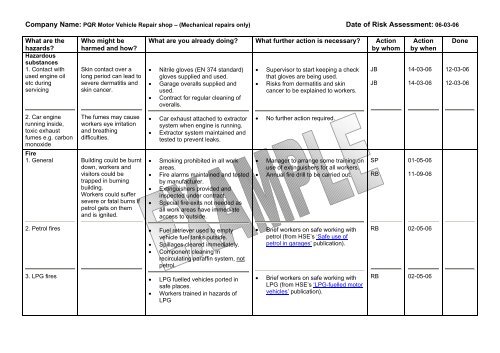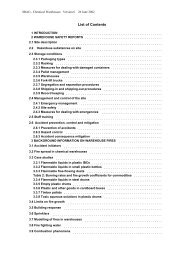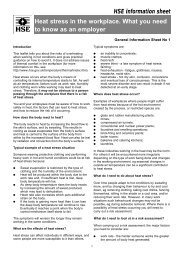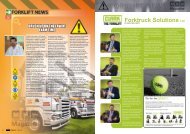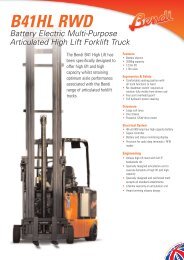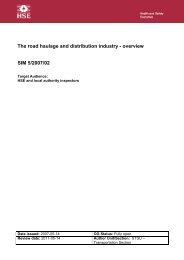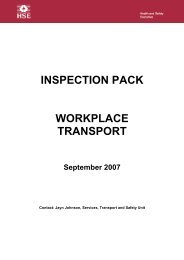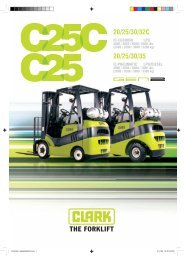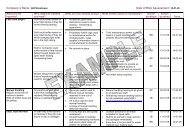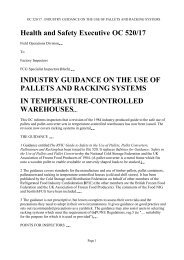Motor vehicle repair example document - Forktruck Solutions Ltd.
Motor vehicle repair example document - Forktruck Solutions Ltd.
Motor vehicle repair example document - Forktruck Solutions Ltd.
Create successful ePaper yourself
Turn your PDF publications into a flip-book with our unique Google optimized e-Paper software.
Company Name: PQR <strong>Motor</strong> Vehicle Repair shop – (Mechanical <strong>repair</strong>s only) Date of Risk Assessment: 06-03-06<br />
What are the<br />
hazards?<br />
Hazardous<br />
substances<br />
1. Contact with<br />
used engine oil<br />
etc during<br />
servicing<br />
Who might be<br />
harmed and how?<br />
Skin contact over a<br />
long period can lead to<br />
severe dermatitis and<br />
skin cancer.<br />
What are you already doing? What further action is necessary? Action<br />
by whom<br />
• Nitrile gloves (EN 374 standard)<br />
gloves supplied and used.<br />
• Garage overalls supplied and<br />
used.<br />
• Contract for regular cleaning of<br />
overalls.<br />
• Supervisor to start keeping a check<br />
that gloves are being used.<br />
• Risks from dermatitis and skin<br />
cancer to be explained to workers.<br />
JB<br />
JB<br />
Action<br />
by when<br />
14-03-06<br />
14-03-06<br />
Done<br />
12-03-06<br />
12-03-06<br />
2. Car engine<br />
running inside,<br />
toxic exhaust<br />
fumes e.g. carbon<br />
monoxide<br />
The fumes may cause<br />
workers eye irritation<br />
and breathing<br />
difficulties.<br />
• Car exhaust attached to extractor<br />
system when engine is running.<br />
• Extractor system maintained and<br />
tested to prevent leaks.<br />
• No further action required.<br />
Fire<br />
1. General<br />
Building could be burnt<br />
down, workers and<br />
visitors could be<br />
trapped in burning<br />
building.<br />
Workers could suffer<br />
severe or fatal burns if<br />
petrol gets on them<br />
and is ignited.<br />
• Smoking prohibited in all work<br />
areas.<br />
• Fire alarms maintained and tested<br />
by manufacturer.<br />
• Extinguishers provided and<br />
inspected under contract.<br />
• Special fire exits not needed as<br />
all work areas have immediate<br />
access to outside.<br />
• Manager to arrange some training on<br />
use of extinguishers for all workers.<br />
• Annual fire drill to be carried out.<br />
SP<br />
RB<br />
01-05-06<br />
11-09-06<br />
2. Petrol fires<br />
• Fuel retriever used to empty<br />
<strong>vehicle</strong> fuel tanks outside.<br />
• Spillages cleared immediately.<br />
• Component cleaning in<br />
recirculating paraffin system, not<br />
petrol.<br />
• Brief workers on safe working with<br />
petrol (from HSE’s ‘Safe use of<br />
petrol in garages’ publication).<br />
RB<br />
02-05-06<br />
3. LPG fires<br />
• LPG fuelled <strong>vehicle</strong>s ported in<br />
safe places.<br />
• Workers trained in hazards of<br />
LPG<br />
• Brief workers on safe working with<br />
LPG (from HSE’s ‘LPG-fuelled motor<br />
<strong>vehicle</strong>s’ publication).<br />
RB<br />
02-05-06
Battery charging<br />
Electrical<br />
equipment<br />
Fixed equipment;<br />
range of portable<br />
appliances e.g.<br />
hand lamps.<br />
Mechanical<br />
Equipment<br />
E.g. grinding<br />
equipment<br />
Falling objects<br />
Car lift failure.<br />
Car jack failure.<br />
Work involving<br />
air conditioning<br />
systems<br />
Workers could suffer<br />
burns from contact<br />
with battery acid whilst<br />
charging, particularly if<br />
battery is overcharged<br />
and explodes.<br />
All workers could<br />
suffer potentially fatal<br />
shocks or burns if they<br />
use faulty electrical<br />
equipment - portable<br />
equipment is<br />
particularly liable to<br />
damage. Faulty<br />
equipment could also<br />
start a fire.<br />
Moving parts can trap<br />
parts of the<br />
employee’s body (e.g.<br />
fingers/hand/arm)<br />
causing crush injuries.<br />
Workers can also cut<br />
themselves on sharp<br />
edges or scald<br />
themselves on hot<br />
parts.<br />
Failure of a car lift or<br />
jack may cause severe<br />
crush injuries to an<br />
employee if a <strong>vehicle</strong><br />
fell on an employee -<br />
those who work in<br />
<strong>vehicle</strong> <strong>repair</strong> are<br />
particularly at risk.<br />
Workers could suffer:<br />
1. Frostbite – through<br />
skin or eye contact<br />
with refrigerant liquid<br />
or gas.<br />
2. Asphyxiation – if<br />
sufficient quantities of<br />
• Proprietary charger, installed by<br />
electrician is used in accordance<br />
with instructions.<br />
• Acid resistant gloves and goggles<br />
supplied and used.<br />
• Hand lamps etc are low voltage<br />
(24 volts).<br />
• A few 240 volt tools are used, all<br />
have industrial plugs and leads.<br />
• Testing carried out annually on all<br />
portable 240v tools and users<br />
trained to carry out visual checks<br />
and report defects.<br />
• Installed equipment receives<br />
regular maintenance.<br />
• All mechanical equipment<br />
checked before use and faults<br />
reported to supervisor.<br />
• Equipment not to be left running<br />
unattended<br />
• Guarding provided.<br />
• Safety goggles provided and<br />
worn.<br />
• Grinding wheels changed by<br />
trained person.<br />
• Car lifts and jacks serviced by<br />
supplier and inspected by<br />
insurers.<br />
• Jacks only used where ground<br />
conditions are firm, stable and<br />
level.<br />
• Axle stands regularly maintained<br />
and inspected.<br />
• Axle stands used after lifting<br />
<strong>vehicle</strong> with jack.<br />
• Safe working loads not exceeded.<br />
• Workers are trained in correct<br />
procedures.<br />
• No further action required.<br />
• Manager to assess suitability of<br />
replacing 240v tools with airpowered<br />
or 110 volt alternatives.<br />
• No further action required.<br />
• No further action required.<br />
• Brief workers on safe working with<br />
air-conditioning systems (from HSE’s<br />
‘Safe working with <strong>vehicle</strong> air<br />
conditioning systems’ publication).<br />
SP<br />
RB<br />
26-04-06<br />
05-07-06
Compressed air<br />
Explosion of<br />
equipment tyres<br />
Injection of air in<br />
the body<br />
Handling <strong>vehicle</strong><br />
air bags<br />
Manual handling<br />
In the store;<br />
movement of<br />
components<br />
Operation of lift<br />
truck<br />
gas escape into<br />
confined space.<br />
3. Exposure to harmful<br />
gases – through<br />
thermal decomposition<br />
of refrigerant if<br />
exposed to a naked<br />
flame.<br />
All workers could<br />
suffer blast injuries if<br />
the air receiver were to<br />
explode; workers could<br />
suffer damage to<br />
internal organs if air is<br />
introduced into the<br />
body.<br />
Air bags could explode<br />
when not fitted,<br />
causing injury.<br />
All workers<br />
(particularly those in<br />
stores) could suffer<br />
from back pain if<br />
regularly lifting/carrying<br />
heavy or awkward<br />
objects.<br />
Injuries such as<br />
fractures can be<br />
incurred by<br />
• the driver crashing<br />
lift truck<br />
• workers and<br />
visitors being hit<br />
by lift truck;<br />
• workers falling<br />
from lift truck;<br />
• objects falling from<br />
lift truck on to<br />
workers and<br />
visitors; and<br />
• All workers trained in safe<br />
working procedures and dangers<br />
of horseplay.<br />
• Airline has deadman’s handle.<br />
• System inspected and serviced<br />
every year by insurers.<br />
• Units are stored in suitable<br />
cabinet of their own.<br />
• Workers are trained in correct<br />
handling and fitting.<br />
• Faulty units are returned to<br />
supplier for disposal.<br />
• Fork-lift truck used to move<br />
material into store and take<br />
components to work shop.<br />
• Manual handling still required.<br />
• All operators trained and<br />
competent for use of the lift truck.<br />
• Truck serviced regularly and<br />
examined every six months.<br />
• Flooring maintained to<br />
reasonable standard.<br />
• Stores laid out to enable truck to<br />
load and unload safely and<br />
pedestrians to pass safely.<br />
• No further action required.<br />
• Brief workers on safe handling of air<br />
bags (from HSE’s ‘A Guide to<br />
handling air bags’ publication).<br />
• Manager to arrange manual handling<br />
training for the workers in the store.<br />
• Brief workers on handling tyres (from<br />
HSE’s ‘Collection and delivery of<br />
tyres guidance’ publication).<br />
• More detailed assessment to be<br />
carried out (using HSE’s Manual<br />
Handling Assessment Chart).<br />
• Supervisor to assess suitability of<br />
pedestrian operated lift trucks.<br />
• Refresher training for operators to be<br />
arranged every 3 years.<br />
RB<br />
SP<br />
RB<br />
JB<br />
JB<br />
SP<br />
01-06-06<br />
10-05-06<br />
22-03-06<br />
22-06-06<br />
01-06-06<br />
21-05-07<br />
22-03-06
Vehicle<br />
movements<br />
Slips and trips<br />
Falls from height<br />
Hygiene and<br />
comfort<br />
Public access to<br />
workshop<br />
• the lift truck<br />
toppling over.<br />
Injuries such as<br />
fractures can occur if<br />
<strong>vehicle</strong>s hit workers or<br />
visitors.<br />
All workers and visitors<br />
may suffer a<br />
strain/sprain or even a<br />
fracture through<br />
slipping on oil/water<br />
spillages.<br />
Injuries such as<br />
fractures may be<br />
incurred by<br />
workers/visitors if they<br />
fall from ladders, the<br />
top of <strong>vehicle</strong>s, or<br />
raised storage areas.<br />
• Safe parking provided for<br />
customers without need for<br />
reversing.<br />
• Marked walked ways for<br />
pedestrians.<br />
• Vehicles driven slowly in/out and<br />
around premises.<br />
• Good housekeeping standards<br />
maintained through training and<br />
monitoring.<br />
• Floors degreased weekly.<br />
• Absorbent granules and sawdust<br />
put on spills as soon as possible.<br />
• Entrances and exits maintained.<br />
• Access equipment provided for<br />
work on trailers and tops of<br />
commercial <strong>vehicle</strong>s.<br />
• Handrails fitted at edges of raised<br />
storage areas and access<br />
stairway provided.<br />
• Workers trained to use ladders<br />
safely.<br />
• Vehicle inspection pits clearly<br />
marked and covered when not in<br />
use.<br />
All workers. • Heated mess room with kitchen<br />
area provided.<br />
• Toilets and sinks available,<br />
cleaned daily.<br />
• Locker room for drying and<br />
storage of own clothes and work<br />
clothing/equipment provided.<br />
• Portable heaters used during the<br />
winter in the workshop.<br />
• Drinking water and cups provided.<br />
Customers could suffer<br />
various injuries if they<br />
wander into the<br />
workshop.<br />
• Signs up banning customers from<br />
the workshop, viewing window<br />
provided in reception.<br />
• Supervisor to monitor speed of cars<br />
in/out and around premises.<br />
• Walkways and storage areas<br />
designated by yellow lines.<br />
• Weekly housekeeping check to be<br />
started.<br />
• Supervisor to monitor use of portable<br />
ladders, access equipment when<br />
working on <strong>vehicle</strong>s, and safety at<br />
inspection pits.<br />
• No further action required.<br />
• Workers to be reminded to challenge<br />
anyone entering the workshop<br />
without permission.<br />
JB<br />
JB<br />
JB<br />
JB<br />
SP<br />
29-03-06 31-03-06<br />
12-04-06 10-04-06<br />
10-03-06 17-03-06<br />
07-04-06 07-04-06<br />
19-05-06<br />
Review Date: 08-01-07


